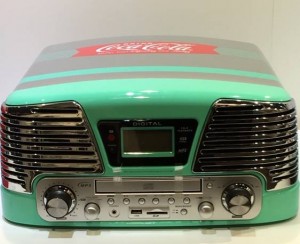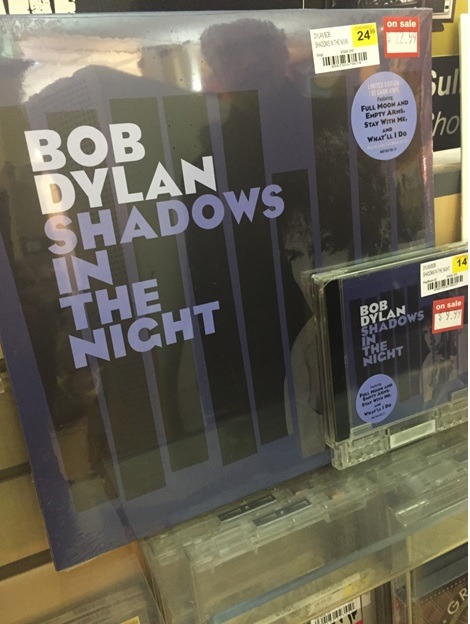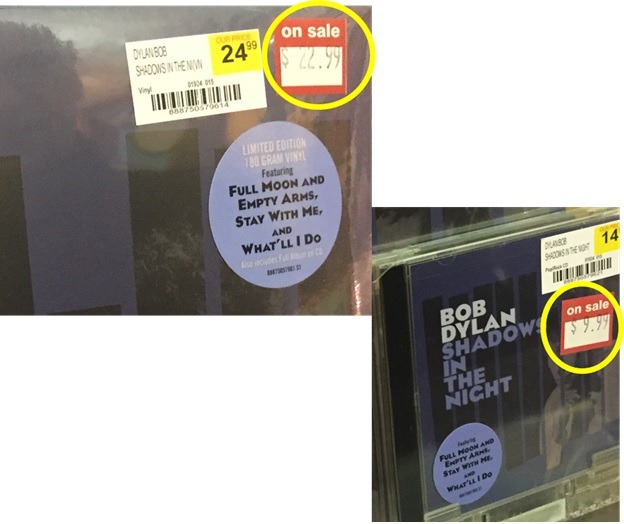What makes something valuable?
Is it strictly based on cost, or the quality, or the time it took to make it?
And what makes one branded item more valuable than another?
Is a Porsche a better car than a Corvette?
Is a Harley a better motorcycle than a Honda?
And would you pay more for a night at the Four Seasons versus a Marriott?
Now you may say these aren’t apples to apples comparisons. A look under the hood of a Porsche or inside a suite at the Four Seasons might suggest an obvious quality difference – or not.
But what about an audio format? Is one worth more than another? Can consumers really differentiate between the quality of an mp3, a CD, or a vinyl album?
That’s what I started asking myself when I saw the new Bob Dylan album at an FYE store in Philadelphia this week:
It’s the same album – Shadows in the Night – but in two different formats: a vinyl album and a CD.
But there’s one big difference: even on sale, the vinyl album costs more than twice as much as the compact disk. How do you explain nearly $23 for the album versus ten bucks for the CD?
And how did the outdated, obsolete, nearly extinct vinyl version of the album become more expensive and desirable than the modern, easier to store, digital version of the exact same collection of songs?
Now you can give me all the technical explanations in the world that rationalizes this major price gap, but I’ll suggest to you this is more like the difference between a plain golf shirt versus the same one with a small alligator logo.
And it’s a lesson for all marketers that value is very much in the eye – or in this case, the ear – of the beholder.
We’ll pay more for desirable brands, and perhaps, the concept of scarcity amps up that value, especially in the case of products that have an aura of cool. For vinyl, however, we’re talking about an amazing comeback for a format that everyone had written off.
But something has been happening with vinyl these past several years. While digital and CD music sales dropped precipitously in 2014, vinyl had “it’s best year in decades,” according to Rolling Stone. Quoting Nielsen data, vinyl enjoyed better than a 50% increase from the previous year. Those classic 12″ platters now make up 6% of all physical music sales.
 But not everyone believes the vinyl resurgence is real. Neil Young spoke about vinyl the other day, calling it “a fashion statement.”
But not everyone believes the vinyl resurgence is real. Neil Young spoke about vinyl the other day, calling it “a fashion statement.”
Here’s why:
“A lot of people that buy vinyl today don’t realize that they’re listening to CD masters on vinyl and that’s because the record companies have figured out that people want vinyl.”
Maybe, but there’s an imprimatur about vinyl that is bolstering its credibility as a desirable art form especially among music fans. And as we saw at CES last month, electronics companies like Thomson are creating devices with built-in turntables like the model shown here that has a decided retro feel.
So maybe Neil Young’s not wrong, and maybe this comeback for old school albums is, in fact, a fad, a status symbol, and yes, even a fashion statement. But somehow, turntables are selling, and right along with them, the 12″ “software” that they play.
It should serve as a suggestion to all of us that place a value on our goods, our services, and our air time, that value really comes down to our ability to market a brand, an image, and an emotion. Like a Porsche or that room at the Four Seasons, vinyl makes people feel good. It’s special, uncommon, and not for everyone.
And that’s precisely why consumers are willing to pay twice as much for it.
Ka-ching.
Thanks to WMMR’s Bill Weston for reminding me of the obvious.
- What To Do If Your Radio Station Goes Through A Midlife Crisis - April 25, 2025
- A 2020 Lesson?It Could All Be Gone In A Flash - April 24, 2025
- How AI Can Give Radio Personalities More…PERSONALITY - April 23, 2025






And that’s exactly how Apple has made its money all these years. God bless the marketing.
Branding and marketing explain a lot. Thanks for chiming in, Jason.
It really always comes down to the value placed on the experience, which in this case includes sitting down to “play a record” and read all of the liner notes etc. The experience is one that at least 2 generations have missed out on. I think it’s very interesting that the adopters are not 50+. As far as Neil Young’s comments, I would just say that maybe SOME people are discovering vinyl for the wrong reasons but it is no worse than the millions of bad, bit-compressed files on every iPod in the world.
And I think you’re right that many of the “late adopters” to vinyl are Millennials in search of a richer experience. Thanks for reminding us of how lucky we were to grow up with record albums, even if you couldn’t “skip” or play them on “shuffle.”
Here’s something to look for . My last album JACK WHITES Lazaretto ULTRA LP:
– 180 gram vinyl
– 2 vinyl-only hidden tracks
– 1 hidden track plays at 78 RPM, one plays at 45 RPM, making this a 3-speed record
– Side A plays from the outside in
– Dual-groove technology: plays an electric or acoustic intro for “Just One Drink” depending on where needle is dropped. The grooves meet for the body of the song.
– Matte finish on Side B, giving the appearance of an un-played 78 RPM record
– Both sides end with locked grooves
– Dead wax area on Side A contains a hand-etched hologram by Tristan Duke of Infinity Light Science, the first of its kind on a vinyl record
– Absolutely zero compression used during recording, mixing and mastering
– Different running order from the CD/digital version
The Most incredible record in my collection. It’s made listening and buying a Record fun again. the (secret)track at 78rpm is on the label !
Best part is holding the record itself . ( You ever try to read the liner notes on a CD without your glasses) YOU CAN READ EVERTHING .Maybe I’m just getting old …but I miss just holding an Album.
Scott, your comment is an eye-opener (to me, at least), explaining what “added value” can be in what has been a traditional format. I wonder if there isn’t an analogy to radio here. Your Jack White album is a great example of taking a familiar, traditional technology and updating and enhancing it, creating a very different and richer experience for the user. (Just don’t scratch it!!). Seriously, thanks for a great point of view.
The other point of the Dylan album is being overlooked: Where is RADIO on this release?
Allow me to share how I bought it, to give some insight of life on the other side of radio. What a “civilian” experienced.
-Got a E-blast from Amazon announcing pre-sale a month ago. (first I heard of the release)
-Agreed to pre-purchase it on vinyl that day.
-Last week, before the LP shipped, Amazon sent me a notice that I could download the LP for free on my phone, from their Amazon Music page.
-Started enjoying Bob that hour.
-LP arrived next day.
-5-days of enjoying this music with no involvement from radio.
No radio play that I’m aware of. No on-air discussion of the project that I’ve heard in my market.
One may argue that there’s no place for a collection of Sinatra songs sung by Dylan in any format available. Well, that’s part of the problem IMHO. But more importantly, there was no attempt on radio’s part to join in (God forbid, lead) the buzz among Baby Boomers over the latest release of one of the World’s living rock legends. It’s a “cultural event” that may have a short shelf-life, but this week it’s real. That’s where our business is having trouble finding it’s role. As far as “why is the LP on vinyl more expensive that the CD or download?” It’s because there is a legitimate cult of vinyl fans out here (old and young) and you can buy a record player for under $100. That’s what I did. Ironic that the business that was built on records and turntables is missing out on the hipster and oldster interest in vinyl. If you REALLY want to blow your mind you’ll research Dylan’s marketing project for this release. Seeking out an old Rolling Stone Magazine writer who now works for AARP’s mag, and agreeing to do an exclusive interview on the LP. Brilliant, and not a record-rep in sight.
Jim, you’ve given commercial radio programmers a lot to think about here. In terms of ignoring the new Dylan album, there are a lot of responsible parties, including me. I can give you the rationale for why Classic Rock radio (for example) has essentially ignored the album, but that misses the point you’re making. The fact is, Dylan has not (in general) been a strong testing artist in recent years, and the bailiwick of new music from classic artists has been a gnarly issue for many years now.
On the one hand, we always hear in focus groups that Classic Rock fans are very interested in hearing new releases from legendary artists. On the other, even some of those same people agree that much of these newer efforts during the past couple of decades haven’t lived up to these artists’ former efforts. Is that because they haven’t been exposed like they were back in the ’70s? Or is it that this material just doesn’t have the same impact the music had back in the day?
That said, every Classic Rock band – from Seger to Clapton to Foghat to the Moody Blues to yes, Bob Dylan – has legions of fans that care very much about their musical heroes. They visit their websites, go to their concerts, and chat about the artist online and over beers. They care, and there ought to be for commercial radio to serve those fans without disrupting the bigger picture.
I have long thought that with the right morning show or classic daypart jock, there would be a way to give a new project like this a couple of “FYI spins,” and then direct the audience to the website and social pages, to sample the music, vote on it, discuss it, and share the experience. It’s the kind of thing that could also be an item in a station email blast. That’s not the same as spinning the new Dylan 5x a day in hot rotation, but given the changing nature of the audience, and they ways they share their tastes, it might fit the times. As you point out, the story is part of the “currency” of Classic Rock, rather than reminding us who played bass on the “Blonde On Blonde” album.
I would be curious to hear from programmers on this, so maybe we’ll get some additional comments. I hate to see Amazon end up getting credit for “breaking new music.” Thanks, Jim, for your passion and for taking the time to weigh in.
You’re right, Fred. I could imagine a morning show playing snippets of cuts, simply for the sake of conversation among the host(s). Not even a whole track.Some of these old standards like “Autumn Leaves” sound very strange, sung by Bob and that it itself is conversation. It would have provided a quarter-hour of content far more engaging and current than reading a week-old story off the web. And then directing listeners who ARE interested to another forum.
Tie in a client-sponsored listener-party where you track the LP at a bar and you could even make money. It’s not rocket-surgery.
No, it’s not. It just takes some thought and creative thinking. The key to keeping a format like Classic Rock fresh is “current events” and this is one of them. Thanks for engaging us, Jim.